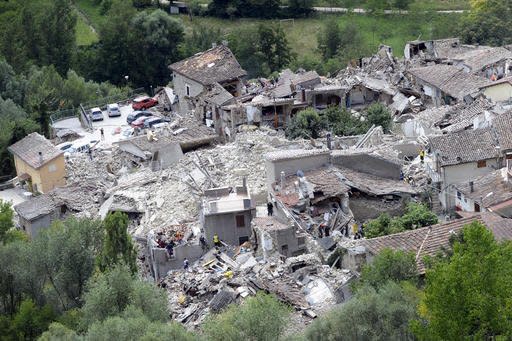Why shallow earthquakes like the one in Italy tend to cause more damage than deep ones

http://syndication.ap.org/AP.Distro.ContentBroker2/ContentBroker.aspx?contentid=cc297947fda44c38af413b8c0e37c196&iid=4dde6f9fb0a64a569f5d35ab15f6d03f&rsn=0&recordid=4dde6f9fb0a64a569f5d35ab15f6d03f&filingId=a57e5ce0fbbc484f83502b21af811dd8&role=Preview&reldt=2016-08-24T17:06:19&media=Photo&sz=74373&dest=ak&trF=PER118&ofn=Italy%2bQuake.JPEG&fmt=jpg&relativeUrl=jpg/2016/201608/24/cc297947fda44c38af413b8c0e37c196.jpg&s3Key=versions/preview-v00.jpg&authToken=eNoti7sOwyAMAL8IZGOeA1J%2fJXGI5KEhCkHt4I9vhi633J22b40UIRWXkAoAOMSsLJXZlVR8Mvu2eOOZsll2j4bWzNAoMZaoXbZnh0A6R%2bV%2b3Jes8%2b7XeK1zyNHGgyFbuyz3t055YoRIen7qX2AAlbMGZ6N16GwOP6zOLbE%3d
LOS ANGELES (AP) — A strong earthquake rocks Italy, flattening towns and killing scores of people. An even bigger quake hits Myanmar the same day, killing a few people and shattering ancient Buddhist pagodas.
How can a larger jolt cause far less damage? A quake's destructive power depends not only on its strength, but also on location, distance from the epicenter and depth.
Quakes can strike near the surface or deep within the Earth. Most quakes occur at shallow depths, according to the US Geological Survey.
Italy's quake was very shallow, originating between 2 1/2 miles and 6 miles underground, according to Italy's geological service and the USGS. The magnitude measurements also varied slightly — between magnitude 6 and 6.2.
By contrast, the 6.8 quake in Myanmar was deeper — at 52 miles, which is considered an intermediate depth.
Shallow quakes generally tend to be more damaging than deeper quakes. Seismic waves from deep quakes have to travel farther to the surface, losing energy along the way.
Shaking is more intense from quakes that hit close to the surface like setting off "a bomb directly under a city," said Susan Hough, a USGS seismologist.
While deep quakes may be less damaging, they're usually more widely felt.
Most of the destruction in the Myanmar quake was centered in the tourist town of Bagan where nearly 100 brick pagodas dating back centuries were damaged. The Italy quake devastated three towns, home to medieval structures built before there were building codes. Many buildings were made of brick or stone, which can fall apart during shaking.
"They're very quaint, but they don't withstand earthquakes very well," Hough said.
NOW WATCH: Huge devastation after 6.2 magnitude earthquake hits central Italy
See Also:

 Yahoo Finance
Yahoo Finance 
